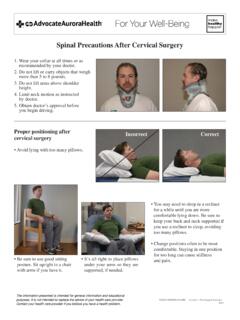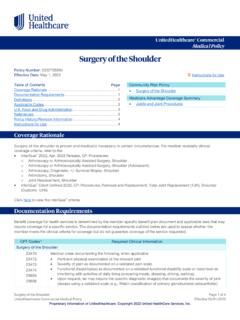Transcription of Shoulder Calcific Tendinitis - NHS Forth Valley
1 Shoulder Calcific Tendinitis Information for patients Orthopaedic Shoulder Service 2 Shoulder Calcific Tendinitis This leaflet will give you some information about Calcific Tendinitis and how it can be managed. Calcific tendonitis is a build-up of calcium in the rotator cuff tendon (group of tendons wrapped around the ball of the Shoulder joint, which helps you to raise and rotate your arm). This calcium deposit may cause a build-up of pressure in the tendon, causing a chemical irritation/inflammation which can lead to you experiencing intense pain. It usually affects people between the age of 30-50 and women are more likely to experience this condition.
2 Key points Calcium deposits cause significant pain and restrict movement in the Shoulder It gets better by itself with time. The severe pain usually resolves within a few months but it can take up to five years for the condition to get completely better The aim of the treatment is to reduce the inflammation in the Shoulder tendon through pain control, anti-inflammatory treatment and gradual rehabilitation of the Shoulder Other treatment options include injections, needling and surgery Shoulder Calcific Tendinitis 3 Calcium deposit in rotator cuff tendon Collar Bone Humerus Shoulder Blade What are the symptoms?
3 The symptoms can vary. Some people may have intermittent moderate pain in their Shoulder and upper arm, which may interfere with their sleep Others, may have an acute attack of intense continuous pain with severe limitation of Shoulder movement which can last for weeks The restricted movement can stop you putting your hand behind you, or being able to reach as far as the back of your head 4 Shoulder Calcific Tendinitis What can I do to help ease the pain? There is strong evidence that simple painkillers and anti- inflammatory tablets significantly help people to manage the pain. Simple medicines such as Paracetamol when taken regularly can greatly reduce the pain you feel.
4 For most people these medicines are safe and have little side effects. If these simple painkillers are not controlling your pain, please contact your Pharmacist or GP to get stronger medication. If you don t like taking medicine, you could try applying anti- inflammatory cream over the tender area. You should check with your Pharmacist or GP to ensure you have no contraindications to using these painkillers. Some people find that heat and cold application helps. For heat, you can try a hot water bottle. For cold, try an ice pack or ice wrapped in cloth. Please be careful not to apply hot or cold packs directly to the skin as they can damage your skin if not used correctly.
5 What can you do to control the symptoms? Calcific tendonitis can be a frustrating and challenging condition to manage. In the acute phase when the Shoulder is very painful, try to avoid the movements that make the pain a lot worse; for example, reaching suddenly, lifting heavy weight and prolonged over-head activities. When your severe pain has settled you should start gentle Shoulder exercises. Shoulder Calcific Tendinitis 5 Physiotherapy It is important to get your pain under control and to keep as much movement in the Shoulder as possible. This keeps the muscles strong and nourishes the joint surface.
6 Simple exercises may help prevent your Shoulder from stiffening up. Please see the separate physiotherapy instruction sheet. We would encourage you to try the exercises daily to strengthen your Shoulder and help settle down the pain. These exercises are a good starting point, but sometimes additional physiotherapy is required. The majority of Shoulder problems get better if you complete the exercises daily. However, it should be appreciated that it can take a number of months of regular exercise to improve. General exercise Many people with Shoulder pain are worried that exercise will cause further damage to the area.
7 However, shoulders are designed to move, and inactivity is harmful to the tissues around the joint and can cause stiffness and weakness, so maintaining movement within the limits of your pain is important. Exercise will also have a positive effect on general fitness. This is best done in liaison with your physiotherapist or GP. It has also been found that exercising other areas of the body can improve the function of your painful Shoulder ; so, general exercise such as walking, swimming or cycling is encouraged in addition to your specific Shoulder exercises. 6 Shoulder Calcific Tendinitis What are your other treatment options?
8 The main aim of treatment for this condition is to control the inflammation of the tendon. There is no one treatment that will reliably cure your Shoulder . Painkillers, gentle exercises and time are the best treatment is a last resort. Injections - Local anaesthetic and steroid (cortisone) injections into the space around the inflamed Shoulder tendons can be tried, though it is difficult to predict how much this might help. Your GP or physiotherapist may be able to offer this. Through-skin Needling (Barbotage) This is an invasive outpatient procedure. An injection needle is put into the Calcific deposit with the aim of removing all, or some of the calcium deposits.
9 A needle is inserted under the guidance of x-ray or ultrasound to enable the clinician to accurately and safely see the needles position. Local anaesthetic will also be administered to make it more comfortable. Shoulder Calcific Tendinitis 7 surgery will not be suitable or necessary for many people. Outcomes from surgery are not significantly better than the other treatment options; your surgeon will discuss the expected success rate along with potential benefits and risks with you. surgery would not guarantee complete pain relief immediately; it takes several weeks for most people to feel some improvement if at all.
10 The operation is performed in hospital under general anaesthesia, usually as a day case. It would be performed as an arthroscopic (through keyhole) procedure. The goal of the surgery is to release and remove all, or some of the calcium deposits from the inflamed Shoulder tendon and to shave off some of the bone above the tendon to increase the amount of free space What are the risks of surgery ? There are risks associated with surgery such as infection, bleeding. It is also possible that you would not get any improvement and your symptoms might actually become worse. A general anaesthetic is usually fairly low risk; however, if you have significant general health problems, the risks with the anaesthetic go up significantly and it may not be sensible for you to have surgery .










